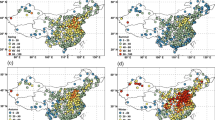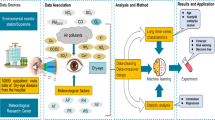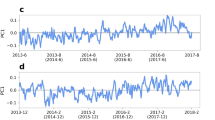Abstract
Elevated levels of particulate matter in the atmosphere are hazardous to human health and the environment. Severe particulate pollution days, with daily mean PM2.5 concentrations exceeding 150 μg m−3, occurred frequently in North China, especially during the boreal winters of 2013–2019. Severe particulate pollution generally occurs under conducive weather patterns characterized by a stable atmosphere with weak winds, under which air pollutants emitted at the surface by human activities would accumulate. The occurrence of conducive weather patterns has been attributed to variations in numerous climate factors such as Arctic sea-ice cover, sea surface temperature and atmospheric teleconnections, but the dominant climate drivers remain unclear. Here, we show that the East Atlantic–West Russia teleconnection pattern and the Victoria mode of sea surface temperature anomalies are the top two dominant climate drivers that lead to conducive weather patterns in North China through the zonal and meridional propagations of Rossby waves. Our results suggest that, with the help of seasonal forecast from climate models, indices of these two drivers can be used to predict severe particulate pollution over North China for the coming winter, enabling us to protect human health by air-quality planning.
This is a preview of subscription content, access via your institution
Access options
Access Nature and 54 other Nature Portfolio journals
Get Nature+, our best-value online-access subscription
$32.99 / 30 days
cancel any time
Subscribe to this journal
Receive 12 print issues and online access
$259.00 per year
only $21.58 per issue
Buy this article
- Purchase on SpringerLink
- Instant access to full article PDF
Prices may be subject to local taxes which are calculated during checkout





Similar content being viewed by others
Data availability
The analytic data that support the major results are accessible at figshare (https://figshare.com/s/be3b2c64e0757e805bf7). The surface PM2.5 observations from the Chinese Ministry of Ecology and Environment can be obtained from http://106.37.208.233:20035/ and https://quotsoft.net/air/. The surface PM2.5 observations for the US Embassy in Beijing are downloaded from https://www.airnow.gov/international/us-embassies-and-consulates/#China$Beijing. The ERA5 reanalysis data are available from https://cds.climate.copernicus.eu/cdsapp#!/search. The NCEP1 renalysis data are available from https://psl.noaa.gov/data/gridded/data.ncep.reanalysis.html. The NCEP2 reanalysis data are available from https://psl.noaa.gov/data/gridded/data.ncep.reanalysis2.html. The observed sea surface temperatures from the Hadley Centre are downloaded from https://www.metoffice.gov.uk/hadobs/hadisst/data/download.html. Source data are provided with this paper.
Code availability
The Cost733class software is open source (http://cost733.met.no/).
References
Cai, W., Li, K., Liao, H., Wang, H. & Wu, L. Weather conditions conducive to Beijing severe haze more frequent under climate change. Nat. Clim. Change 7, 257–262 (2017).
Li, J., Liao, H., Hu, J. & Li, N. Severe particulate pollution days in China during 2013–2018 and the associated typical weather patterns in Beijing–Tianjin–Hebei and the Yangtze River delta regions. Environ. Pollut. 248, 74–81 (2019).
Yang, Y., Liao, H. & Lou, S. Increase in winter haze over eastern China in recent decades: roles of variations in meteorological parameters and anthropogenic emissions. J. Geophys. Res. Atmos. 121, 13050–13065 (2016).
Yue, X. et al. Ozone and haze pollution weakens net primary productivity in China. Atmos. Chem. Phys. 17, 6073–6089 (2017).
Hu, J. et al. Premature mortality attributable to particulate matter in China: source contributions and responses to reductions. Environ. Sci. Technol. 51, 9950–9959 (2017).
Hao, X. et al. Long-term health impact of PM2.5 under whole-year COVID-19 lockdown in China. Environ. Pollut. 290, 118118 (2021).
Li, Z. et al. Aerosol and monsoon climate interactions over Asia. Rev. Geophys. 54, 866–929 (2016).
Wang, Y. et al. Mechanism for the formation of the January 2013 heavy haze pollution episode over central and eastern China. Sci. China Earth Sci. 57, 14–25 (2014).
Zhang, Q. et al. Drivers of improved PM2.5 air quality in China from 2013 to 2017. Proc. Natl Acad. Sci. USA 116, 24463–24469 (2019).
Huang, X. et al. Enhanced secondary pollution offset reduction of primary emissions during COVID-19 lockdown in China. Natl Sci. Rev. 8, nwaa137 (2020).
Wang, P., Chen, K., Zhu, S., Wang, P. & Zhang, H. Severe air pollution events not avoided by reduced anthropogenic activities during COVID-19 outbreak. Resour. Conserv. Recycl. 158, 104814 (2020).
Zhao, X. J. et al. Analysis of a winter regional haze event and its formation mechanism in the North China Plain. Atmos. Chem. Phys. 13, 5685–5696 (2013).
Liu, C. et al. A severe fog-haze episode in Beijing–Tianjin–Hebei region: characteristics, sources and impacts of boundary layer structure. Atmos. Pollut. Res. 10, 1190–1202 (2019).
Chen, H. & Wang, H. Haze days in North China and the associated atmospheric circulations based on daily visibility data from 1960 to 2012. J. Geophys. Res. Atmos. 120, 5895–5909 (2015).
Pei, L., Yan, Z., Sun, Z., Miao, S. & Yao, Y. Increasing persistent haze in Beijing: potential impacts of weakening East Asian winter monsoons associated with northwestern Pacific sea surface temperature trends. Atmos. Chem. Phys. 18, 3173–3183 (2018).
Wu, P., Ding, Y. & Liu, Y. Atmospheric circulation and dynamic mechanism for persistent haze events in the Beijing–Tianjin–Hebei region. Adv. Atmos. Sci. 34, 429–440 (2017).
An, Z. et al. Severe haze in northern China: a synergy of anthropogenic emissions and atmospheric processes. Proc. Natl Acad. Sci. USA 116, 8657–8666 (2019).
Zhao, S., Feng, T., Tie, X., Li, G. & Cao, J. Air pollution zone migrates south driven by East Asian winter monsoon and climate change. Geophys. Res. Lett. 48, e2021GL092672 (2021).
Wu, G. et al. Advances in studying interactions between aerosols and monsoon in China. Sci. China Earth Sci. 59, 1–16 (2016).
Wang, H., Chen, H. & Liu, J. Arctic sea ice decline intensified haze pollution in eastern China. Atmos. Ocean Sci. Lett. 8, 1–9 (2015).
Wang, J. et al. Two pathways of how remote SST anomalies drive the interannual variability of autumnal haze days in the Beijing–Tianjin–Hebei region, China. Atmos. Chem. Phys. 19, 1521–1535 (2019).
Yin, Z. & Wang, H. The relationship between the subtropical western Pacific SST and haze over north-central North China Plain. Int. J. Climatol. 36, 3479–3491 (2016).
Chen, S., Guo, J., Song, L., Cohen, J. B. & Wang, Y. Temporal disparity of the atmospheric systems contributing to interannual variation of wintertime haze pollution in the North China Plain. Int. J. Climatol. 40, 128–144 (2020).
Shen, L., Jacob, D. J., Mickley, L. J., Wang, Y. & Zhang, Q. Insignificant effect of climate change on winter haze pollution in Beijing. Atmos. Chem. Phys. 18, 17489–17496 (2018).
Yin, Z. & Wang, H. Role of atmospheric circulations in haze pollution in December 2016. Atmos. Chem. Phys. 17, 11673–11681 (2017).
Zou, Y., Wang, Y., Xie, Z., Wang, H. & Rasch, P. J. Atmospheric teleconnection processes linking winter air stagnation and haze extremes in China with regional Arctic sea ice decline. Atmos. Chem. Phys. 20, 4999–5017 (2020).
Zou, Y., Wang, Y., Zhang, Y. & Koo, J. H. Arctic sea ice, Eurasia snow, and extreme winter haze in China. Sci. Adv. 3, e1602751 (2017).
Pei, L. & Yan, Z. Diminishing clear winter skies in Beijing towards a possible future. Environ. Res. Lett. 13, 124029 (2018).
Chen, H., Wang, H., Sun, J., Xu, Y. & Yin, Z. Anthropogenic fine particulate matter pollution will be exacerbated in eastern China due to 21st century GHG warming. Atmos. Chem. Phys. 19, 233–243 (2019).
Wallace, J. M. & Gutzler, D. S. Teleconnections in the geopotential height field during the Northern Hemisphere winter. Mon. Weather Rev. 109, 784–812 (1981).
Horel, J. D. & Wallace, J. M. Planetary-scale atmospheric phenomena associated with the Southern Oscillation. Mon. Weather Rev. 109, 813–829 (1981).
Krichak, S. O., Breitgand, J. S., Gualdi, S. & Feldstein, S. B. Teleconnection–extreme precipitation relationships over the Mediterranean region. Theor. Appl. Climatol. 117, 679–692 (2013).
Lim, Y.-K. The East Atlantic/West Russia (EA/WR) teleconnection in the North Atlantic: climate impact and relation to Rossby wave propagation. Clim. Dyn. 44, 3211–3222 (2014).
Ding, R., Li, J., Tseng, Y.-h., Sun, C. & Guo, Y. The Victoria mode in the North Pacific linking extratropical sea level pressure variations to ENSO. J. Geophys. Res. Atmos. 120, 27–45 (2015).
Bond, N. A., Overland, J. E., Spillane, M. & Stabeno, P. Recent shifts in the state of the North Pacific. Geophys. Res. Lett. 30, 2183 (2003).
Ding, R., Li, J., Tseng, Y.-h., Sun, C. & Zheng, F. Linking a sea level pressure anomaly dipole over North America to the central Pacific El Niño. Clim. Dyn. 49, 1321–1339 (2017).
Tanaka, S., Nishii, K. & Nakamura, H. Vertical structure and energetics of the western Pacific teleconnection pattern. J. Clim. 29, 6597–6616 (2016).
Shen, G. et al. Impacts of air pollutants from rural Chinese households under the rapid residential energy transition. Nat. Commun. 10, 3405 (2019).
Dang, R. & Liao, H. Severe winter haze days in the Beijing–Tianjin–Hebei region from 1985 to 2017 and the roles of anthropogenic emissions and meteorology. Atmos. Chem. Phys. 19, 10801–10816 (2019).
Zhang, Y., Yin, Z. & Wang, H. Roles of climate variability on the rapid increases of early winter haze pollution in North China after 2010. Atmos. Chem. Phys. 20, 12211–12221 (2020).
Hersbach, H. et al. The ERA5 global reanalysis. Q. J. R. Meteorol. Soc. 146, 1999–2049 (2020).
Kalnay, E. et al. The NCEP/NCAR 40-year reanalysis project. Bull. Am. Meteorol. Soc. 77, 437–472 (1996).
Kanamitsu, M. et al. NCEP-DOE AMIP-II Reanalysis (R-2). Bull. Am. Meteorol. Soc. 83, 1631–1644 (2002).
Rayner, N. A. Global analyses of sea surface temperature, sea ice, and night marine air temperature since the late nineteenth century. J. Geophys. Res. 108, 4407 (2003).
Barnston, A. G. & Livezey, R. E. Classification, seasonality and persistence of low-frequency atmospheric circulation patterns. Mon. Weather Rev. 115, 1083–1126 (1987).
Huth, R. et al. Classifications of atmospheric circulation patterns: recent advances and applications. Ann. N. Y. Acad. Sci. 1146, 105–152 (2008).
Zhang, J. P. et al. The impact of circulation patterns on regional transport pathways and air quality over Beijing and its surroundings. Atmos. Chem. Phys. 12, 5031–5053 (2012).
Wang, X. & Zhang, R. Effects of atmospheric circulations on the interannual variation in PM2.5 concentrations over the Beijing–Tianjin–Hebei region in 2013–2018. Atmos. Chem. Phys. 20, 7667–7682 (2020).
Xu, J. et al. The meteorological modulation on PM2.5 interannual oscillation during 2013 to 2015 in Shanghai, China. Sci. Total Environ. 572, 1138–1149 (2016).
Philipp, A. et al. Cost733cat—a database of weather and circulation type classifications. Phys. Chem. Earth Part A/B/C 35, 360–373 (2010).
Murawski, A., Bürger, G., Vorogushyn, S. & Merz, B. Can local climate variability be explained by weather patterns? A multi-station evaluation for the Rhine basin. Hydrol. Earth Syst. Sci. 20, 4283–4306 (2016).
Boers, N. et al. Complex networks reveal global pattern of extreme-rainfall teleconnections. Nature 566, 373–377 (2019).
Plumb, R. A. On the three-dimensional propagation of stationary waves. J. Atmos. Sci. 42, 217–229 (1985).
Acknowledgements
H.L. acknowledges the National Natural Science Foundation of China (grant nos. 42021004 and 91744311) and the Major Research Plan of the National Social Science Foundation (grant no. 18ZDA052). X.H. is supported by the National Natural Science Foundation of China (grant no. 42088101) and the Guangdong Major Project of Basic and Applied Basic Research (grant no. 2020B0301030004).
Author information
Authors and Affiliations
Contributions
J.L., X.H. and H.L. conceived the study. J.L. and X.H. performed the data analysis. Y.W. and W.C. contributed to interpreting the scientific questions. J.L., X.H. and H.L. wrote the draft of the manuscript. All authors contributed to discussing and improving the manuscript.
Corresponding author
Ethics declarations
Competing interests
The authors declare no competing interests.
Peer review
Peer review information
Nature Geoscience thanks the anonymous reviewers for their contribution to the peer review of this work. Primary Handling Editors: Xujia Jiang and James Super, in collaboration with the Nature Geoscience team.
Additional information
Publisher’s note Springer Nature remains neutral with regard to jurisdictional claims in published maps and institutional affiliations.
Extended data
Extended Data Fig. 1 Correlation between daily meteorology anomalies and winter PM2.5.
a, Topographic map of the North China Plain (shading, unit: m) and locations of cities (black dots) with observed PM2.5 concentrations used in this study. b-m, Distribution of correlation coefficients between daily mean PM2.5 concentrations and daily meteorological fields during DJFs from 2013 to 2019. Stippled regions in b-m denote those areas exceeding the 95% significance level based on the Student’s t-test. The blue line is the boundary of the BTH region.
Extended Data Fig. 2 Regression between daily meteorological anomalies and winter PM2.5.
Distribution of regression coefficients between daily mean PM2.5 concentrations with daily (a) U200, (b) Z500, (c) V850, (d) RH1000 (relative humidity at 1000 hPa) and (e) Deltem_850_250 (vertical difference in the temperature anomalies between 850 hPa and 250 hPa) during DJFs from 2013 to 2019. Stippled regions denote those areas exceeding the 95% significance level based on the Student’s t-test. The blue line is the boundary of the BTH region. The black rectangles in a-c are selected regions for each variable.
Extended Data Fig. 3 Composited weather patterns for T1–T7 during the DJFs of 2013–2019.
a-bb, Composite anomalies of (a-g) U200 (units: m s−1), (h-n) Z500 (units: m), (o-u) V850 (units: m s−1), and (v-bb) pressure-longitude cross sections of the relative humidity (shadings, units: %) and temperature (contour, unit: °C) for each weather type. The gray contours in a-g are the western jet streams calculated by the DJF means of U200 from 1979 to 2018. The cross sections in v-bb are averaged over 30–40°N, and areas between the two black dashed lines denote the BTH region.
Extended Data Fig. 4 Evaluation for different classifications.
a, The explained variation (EV) and pseudo-F (PF) values for different classifications. b-e, Box and whisker plots of the average PM2.5 concentrations (b, c) and frequencies of SPPDs (d, e) under each Type for 6 (b, d) and 7 (c, e) classes in a. The red dots in boxes (b, c) denote mean PM2.5 concentrations and their values are listed below boxes. The numbers above the histograms are the frequencies of each type in DJFs during 2013–2019, and those below the histograms are the SPPDs frequencies within each type.
Extended Data Fig. 5 Long-term variations of reconstructed conducive weather patterns using different reanalysis datasets.
a-c, Time series of occurrence frequencies for the R-CWPs in winters of 1979–2019 by using the ERA5 (red), NCEP1(blue), and NCEP2 (green) reanalysis datasets, respectively. The inset texts in the top right corner of each panel denote correlation coefficients between R-CWPs with ERA5 reanalysis and R-CWPs using NCEP1 and NCEP2 reanalysis in 1979-2019, respectively.
Extended Data Fig. 6 Reconstructed conducive weather patterns for T5 and T7 over the years of 1979–2019.
a-h, Composite anomaly distributions of (a, b) U200 (units: m s−1), (c, d) Z500 (units: m), (e, f) V850 (units: m s−1) and (g, h) pressure-longitude cross sections of the relative humidity (shadings, units: %) and temperature (contour, unit: °C) for the reconstructed T5 and T7 weather types. The gray contours in a and b are the western jet streams calculated by the DJF means of U200 from 1979 to 2018. The cross sections are averaged over 30–40°N, and areas between the two black dashed lines denote the BTH region. The “Pattern corr” in a-f denote the pattern correlation between the composites in Fig. 1c-h and a-f.
Extended Data Fig. 7 Relationship between T5 and atmospheric indices.
Extended Data Fig. 8 Relationship between T7 and atmospheric indices.
Heatmap of correlation coefficients between various atmospheric indices and frequency of reconstructed T5 weather pattern.
Extended Data Fig. 9 Relationship between T5/T7 and SST indices.
Heatmap of correlation coefficients between SST indices and frequency of reconstructed T5 (top panel) and T7 (bottom panel) weather pattern.
Supplementary information
Supplementary Information
Supplementary Texts 1 and 2, Tables 1 and 2, and Figs. 1–5.
Source data
Source Data Fig. 1
Source Data.
Source Data Fig. 2
Source Data.
Source Data Fig. 3
Source Data.
Source Data Fig. 4
Source Data.
Source Data Fig. 5
Source Data.
Source Data Extended Data Fig. 1
Source Data.
Source Data Extended Data Fig. 2
Source Data.
Source Data Extended Data Fig. 3
Source Data.
Source Data Extended Data Fig. 4
Source Data.
Source Data Extended Data Fig. 5
Source Data.
Source Data Extended Data Fig. 6
Source Data.
Source Data Extended Data Fig. 7
Source Data.
Source Data Extended Data Fig. 8
Source Data.
Source Data Extended Data Fig. 9
Source Data.
Rights and permissions
About this article
Cite this article
Li, J., Hao, X., Liao, H. et al. Winter particulate pollution severity in North China driven by atmospheric teleconnections. Nat. Geosci. 15, 349–355 (2022). https://doi.org/10.1038/s41561-022-00933-2
Received:
Accepted:
Published:
Issue date:
DOI: https://doi.org/10.1038/s41561-022-00933-2
This article is cited by
-
Unprecedented shifts in aerosol pollution sources in China under a decade of clean air actions
Communications Earth & Environment (2025)
-
Dominant synoptic circulation patterns of the winter warm spells in North China and the joint influence from the central-eastern and subtropical North Atlantic
Climate Dynamics (2025)
-
Anthropogenic warming degrades spring air quality in Northeast Asia by enhancing atmospheric stability and transboundary transport
npj Climate and Atmospheric Science (2024)
-
Enhanced North Pacific Victoria mode in a warming climate
npj Climate and Atmospheric Science (2024)
-
A new dipole index for the North Pacific Victoria mode
Climate Dynamics (2024)



